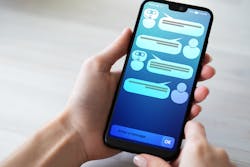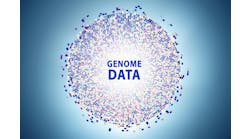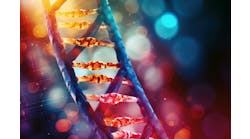A clinical trial involving University of Utah Health and NYU Langone Health in New York is seeking to identify patients who qualify for genetic risk assessment using a clinical decision support algorithm to automatically evaluate family history of cancer. The BRIDGE Trial also is testing the use of a chatbot for patient outreach.
At last week’s National Human Genome Research Institute meeting on “genomic learning healthcare systems,” Guilherme Del Fiol, M.D., Ph.D., associate professor and vice-chair of research in the University of Utah’s Department of Biomedical Informatics, described the BRIDGE (Broadening the Reach, Impact, and Delivery of Genetic Services) Trial.
This randomized controlled trial has been funded by two grants from the National Cancer Institute, one of them focused on a software platform for population-level, genomic clinical decision support, and the other one is a randomized multi-site trial using this platform for a specific use case.
Kimberly Kaphingst, ScD, a professor in the Department of Communication and the director of Cancer Communication Research at the Huntsman Cancer Institute (HCI) at the University of Utah, is the principal investigator on the project.
“The original motivation for this project was the finding that about 13 percent of individuals are at elevated risk for familial breast and colorectal cancer, and that most of these individuals are unaware of their risk,” Del Fiol said, “and at the same time, there are evidence-based guidelines recommending genetic testing based on their family history.”
The goals of the project were essentially to enable a population health management platform that allows clinicians to use computable logic to identify patients who meet evidence-based criteria for genetic testing, and then to use a registry-based approach with patient outreach tools to manage the risk, he explained.
“We leverage family history that's available in the EHR, and we do not try to collect or improve the collection of family history,” Del Fiol stressed. Another essential part of the strategy is that in order to minimize primary care effort, primary care providers are kept into the loop of this whole process, but they are not asked to do anything extra.
Part of the innovation is to try to use automated chatbots for the patient outreach process, which includes patient education, in offering genetic testing. The BRIDGE Trial is about to finish enrollment at University of Utah Health and New York University Langone Health.
From the project website, here is information on the BRIDGE Trial’s goals:
- Identify unaffected primary care patients who qualify for genetic risk assessment using a clinical decision support algorithm to automatically evaluate family history of cancer.
- Compare uptake of genetic testing for patient-directed vs. enhanced standard of care genetic services delivery models among unaffected primary care patients.
- Compare adherence to clinical care recommendations and patient cognitive and affective responses for the genetic services delivery models.
The researchers hypothesize that uptake of genetic counseling and genetic testing will be equivalent between the chatbot and the genetic services delivery models. They also plan to explore how race, ethnicity, and geographic location modify the effects of the cancer genetics services delivery models on the outcomes.
Del Fiol said the project involves use of the OpenCDS platform. OpenCDS is a multi-institutional, collaborative effort to develop open-source, standards-based clinical decision support (CDS) tools and resources that can be widely adopted to enable CDS at scale.
Del Fiol explained how the system works: The population coordinator system identifies a screening population, which in this case is basically everyone who meets a certain age range and has been seen in a primary care at University of Utah or NYU-Langone. The population coordinator retrieves data from these patients and transforms everything into FHIR from the EHR. Next, FHIR data is transmitted to OpenCDS in bulk. OpenCDS has an interface based on the CDS Hooks standard, which is a clinical decision support services standard that allows an independent service to receive a request to analyze patients according to certain logic, and then respond with the results of those analyses — all in a standard format. CDS Hooks uses FHIR as the data standard both for requests and responses.
The results are then exported back into the EHR. “In our case, for Epic, it uses Epic’s population registry solution,” Del Fiol said. “We load patients who meet criteria into the registry, and then the genetic counseling assistants uses that registry functionality to manage the population and conduct patient outreach activities.”
This platform is supporting the BRIDGE trial, which is comparing two approaches for patient education and outreach, with the goal of offering genetic testing for patients who meet family history-based criteria. There are two arms of the study, Del Fiol explained. “One is our usual care, which basically involves genetic counselors making phone calls to those patients, one by one, providing some education over the phone, in trying to schedule a genetic counseling appointment. The alternative approach in the second arm of the study is using an automated chatbot, which provides education about genetics and then at the very end of a chatbot conversation, it offers the option to receive genetic testing. If they decide to do testing, they receive a kit in the mail, collect the sample at home, mail the sample back to the lab, and an outreach note is written back into Epic with the patient's decision and the transcript of that conversation.”
For patients who test positive, they get a genetic counseling appointment, and are basically back to the usual care workflow. But most patients test negative and are managed in an automated fashion using the chatbot. In both cases, a note is written into the EHR, with clinical recommendations. For patients who test negative that's an automated note, and for patients whose test positive, the note is written by a genetic counselor.
So far, more than 3,000 patients have received outreach in one of the two study arms. “I'm not going to make comparisons here because the trial hasn't been completed yet,” he said, “but so far, 23 percent of the people who received an offer to use the chatbot or receive the phone call for genetic counseling completed the entire process — they either completed the chatbot interaction, or they scheduled a genetic counseling appointment and had that appointment completed.
Del Fiol described some early lessons learned in this process. “We found that using chatbots does seem to be a scalable approach for patient outreach and engagement. It minimizes the genetic counseling efforts,” he said.
Overall, family history data is incomplete in the EHR. “But when you have a family history assertion in the EHR, we found that it's largely correct, and rarely leads to false positive patient identification, he added.
Regarding clinical workflow, they tested interoperability using two EHR systems at three institutions, two on Epic and one on Cerner. “At Intermountain Healthcare, we demonstrated that this works with a Cerner system, but we found there are significant disparities in family history documentation across different patient populations," he added. In addition, one problem with the chatbot is that it really relies on smartphone technology, and higher percentages of the people in low-SES and rural populations don't have a smartphone.


